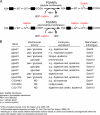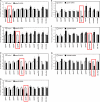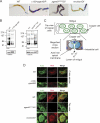Multiple members of the UDP-GalNAc: polypeptide N-acetylgalactosaminyltransferase family are essential for viability in Drosophila
- PMID: 22157008
- PMCID: PMC3285305
- DOI: 10.1074/jbc.M111.306159
Multiple members of the UDP-GalNAc: polypeptide N-acetylgalactosaminyltransferase family are essential for viability in Drosophila
Abstract
Mucin-type O-glycosylation represents a major form of post-translational modification that is conserved across most eukaryotic species. This type of glycosylation is initiated by a family of enzymes (GalNAc-Ts in mammals and PGANTs in Drosophila) whose members are expressed in distinct spatial and temporal patterns during development. Previous work from our group demonstrated that one member of this family is essential for viability and another member modulates extracellular matrix composition and integrin-mediated cell adhesion during development. To investigate whether other members of this family are essential, we employed RNA interference (RNAi) to each gene in vivo. Using this approach, we identified 4 additional pgant genes that are required for viability. Ubiquitous RNAi to pgant4, pgant5, pgant7, or the putative glycosyltransferase CG30463 resulted in lethality. Tissue-specific RNAi was also used to define the specific organ systems and tissues in which each essential family member is required. Interestingly, each essential pgant had a unique complement of tissues in which it was required. Additionally, certain tissues (mesoderm, digestive system, and tracheal system) required more than one pgant, suggesting unique functions for specific enzymes in these tissues. Expanding upon our RNAi results, we found that conventional mutations in pgant5 resulted in lethality and specific defects in specialized cells of the digestive tract, resulting in loss of proper digestive system acidification. In summary, our results highlight essential roles for O-glycosylation and specific members of the pgant family in many aspects of development and organogenesis.
Figures




Similar articles
-
Dissecting the biological role of mucin-type O-glycosylation using RNA interference in Drosophila cell culture.J Biol Chem. 2010 Nov 5;285(45):34477-84. doi: 10.1074/jbc.M110.133561. Epub 2010 Aug 31. J Biol Chem. 2010. PMID: 20807760 Free PMC article.
-
Expression of the UDP-GalNAc: polypeptide N-acetylgalactosaminyltransferase family is spatially and temporally regulated during Drosophila development.Glycobiology. 2006 Feb;16(2):83-95. doi: 10.1093/glycob/cwj051. Epub 2005 Oct 26. Glycobiology. 2006. PMID: 16251381
-
Functional characterization and expression analysis of members of the UDP-GalNAc:polypeptide N-acetylgalactosaminyltransferase family from Drosophila melanogaster.J Biol Chem. 2003 Sep 12;278(37):35039-48. doi: 10.1074/jbc.M303836200. Epub 2003 Jun 26. J Biol Chem. 2003. PMID: 12829714
-
The cellular microenvironment and cell adhesion: a role for O-glycosylation.Biochem Soc Trans. 2011 Jan;39(1):378-82. doi: 10.1042/BST0390378. Biochem Soc Trans. 2011. PMID: 21265808 Free PMC article. Review.
-
Polypeptide N-acetylgalactosaminyltransferase-Associated Phenotypes in Mammals.Molecules. 2021 Sep 10;26(18):5504. doi: 10.3390/molecules26185504. Molecules. 2021. PMID: 34576978 Free PMC article. Review.
Cited by
-
Advances in protein glycosylation and its role in tissue repair and regeneration.Glycoconj J. 2023 Jun;40(3):355-373. doi: 10.1007/s10719-023-10117-8. Epub 2023 Apr 25. Glycoconj J. 2023. PMID: 37097318 Review.
-
O-glycosylation regulates polarized secretion by modulating Tango1 stability.Proc Natl Acad Sci U S A. 2014 May 20;111(20):7296-301. doi: 10.1073/pnas.1322264111. Epub 2014 May 5. Proc Natl Acad Sci U S A. 2014. PMID: 24799692 Free PMC article.
-
Functional analysis of glycosylation using Drosophila melanogaster.Glycoconj J. 2020 Feb;37(1):1-14. doi: 10.1007/s10719-019-09892-0. Epub 2019 Nov 26. Glycoconj J. 2020. PMID: 31773367 Review.
-
Mucin-Type O-Glycosylation in Invertebrates.Molecules. 2015 Jun 9;20(6):10622-40. doi: 10.3390/molecules200610622. Molecules. 2015. PMID: 26065637 Free PMC article. Review.
-
RNAi-Mediated Silencing of Pgants Shows Core 1 O-Glycans Are Required for Pupation in Tribolium castaneum.Front Physiol. 2021 Mar 24;12:629682. doi: 10.3389/fphys.2021.629682. eCollection 2021. Front Physiol. 2021. PMID: 33841170 Free PMC article.
References
-
- Schachter H. (2010) Mgat1-dependent N-glycans are essential for the normal development of both vertebrate and invertebrate metazoans. Semin. Cell Dev. Biol. 21, 609–615 - PubMed
Publication types
MeSH terms
Substances
Grants and funding
LinkOut - more resources
Full Text Sources
Molecular Biology Databases

